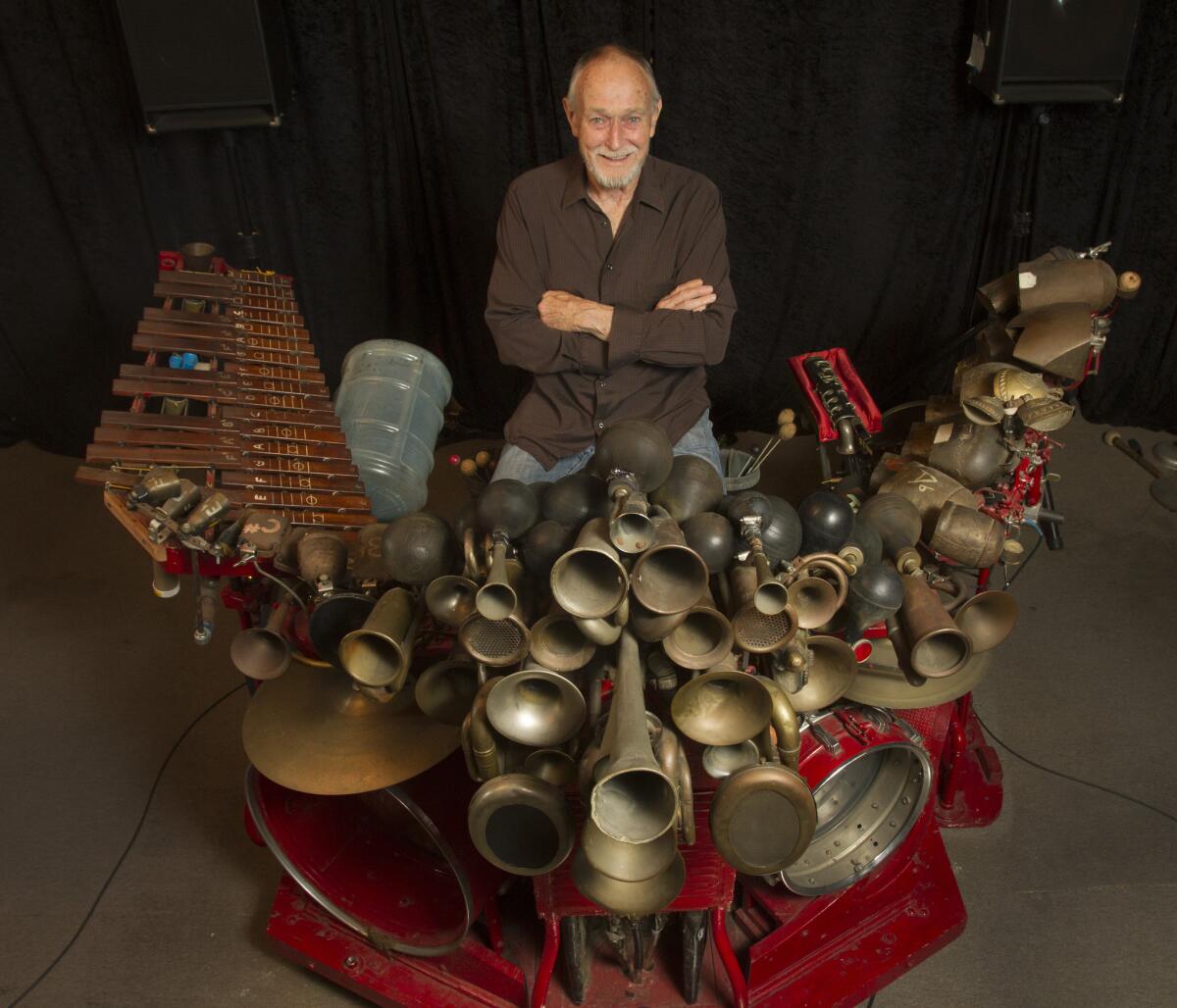Maverick Llyn Foulkes is finally inside the art world — at age 79

It’s eerily quiet at Llyn Foulkes’ Church of Art, a.k.a. his studio at the Brewery arts complex in downtown Los Angeles. Rows of empty metal folding chairs face a small, altar-like stage; floral air freshener, mixed with the sharp scent of turpentine, permeates the cavernous room.
A reporter and the artist’s press representative are enough of an audience for the 79-year-old Foulkes, a maverick painter who came out of the ‘50s and ‘60s Pop art scene. Foulkes started at Los Angeles’ Ferus Gallery alongside artists such as Ed Ruscha, Robert Irwin and Ed Moses, but then faded from the limelight for decades until a recent comeback that included a Hammer Museum retrospective in 2013 — so no attention goes unappreciated.
In a worn, paint-stained Oxford, Foulkes climbs onto the stage and settles in behind his homemade, one-man-band contraption, “The Machine,” a sculptural configuration of cow bells, drums, organ pipes, antique car horns and hoses, among other things. He squeezes a rubber horn here, bangs on an empty water bottle there, his blue eyes shining at the hollow thumps and squeaky hoots. Then he runs his drumstick across the keys of a xylophone, clears his throat and launches into a jazzy bit — but never so lost in the music as to forgo intermittent eye contact with his audience.
“Most people don’t understand what goes into this,” Foulkes says, working the foot pedals, xylophone sticks and horns at once. “What I’m doing with the music is heartfelt and complex; I just don’t think my machine has been given enough credit.”
Not getting his due is Foulkes’ No. 1 gripe and the subject of a documentary film that opened in L.A. theaters on Friday. In “Llyn Foulkes One Man Band,” filmed on and off over seven years, directors Tamar Halpern and Chris Quilty follow the outsider artist’s painstakingly meticulous creation of two large-scale paintings, “The Lost Frontier” and “The Awakening”; the film also more broadly charts his tumultuous career. At its heart, however, the film is about Foulkes’ uncompromising artistic vision, his self-described narcissism and his insatiable desire for recognition from the art world establishment, friends and family.
“Ever since I was a kid, I wanted to be a famous artist like Salvador Dalí or Picasso,” he says, pausing to light a cigarette. “In my family, no one ever hugged or kissed. This was up in Yakima [Wash.]. I’d do little performances for my mother and her sister … and it all felt like you wouldn’t really be loved unless you were a star. And I have never gotten over that, never.”
After two years at the Chouinard Art Institute (now the California Institute of the Arts), Foulkes became something of an art world darling when he began showing his mixed media collages at Ferus in 1961. His pointed opinions about other artists’ work and his penchant for speaking his mind eventually got him kicked out of the gallery.
But no matter. Foulkes was already successful. He had a solo show at the Pasadena Art Museum (now the Norton Simon), his postcard paintings and textured rock landscapes were popular with collectors, and five major museums including LACMA and the Art Institute of Chicago purchased his work.
“He was set be one of the great American masters, and that didn’t happen,” Halpern says. “He stopped producing the rock landscapes because he felt he was losing his soul. They were too easy.”
Foulkes sold his work and had some intermittent successes, including inclusion in the Museum of Contemporary Art’s 1992 “Helter Skelter” show. But he wasn’t able to reattain the peak of public attention he enjoyed early on — not until the Hammer retrospective last year.
“He was rediscovered at age 77,” Halpern says, “and that’s the most hopeful thing any artist can hear.”
Halpern met Foulkes in the ‘90s when they were neighbors at the Brewery, where Foulkes has lived and worked for 16 years. She cast him in an independent feature she wrote and directed in 2005, “Your Name Here,” about two 15-year-olds aiming to start a band. Foulkes — a member of the Rubber Band, which broke up because of infighting — played an advice-offering grandfather suggesting that it’s better to be in a one-man band than a collaborative musical effort.
Halpern also spent about five months in 2004 filming Foulkes as he raced to finish the painting “The Lost Frontier” for a show at Kent Gallery in New York. The result was a short documentary, “Llyn Foulkes’ Lost Frontier,” that played during the Kent opening.
Foulkes is famous for his obsessive process, reworking paintings over years — even destroying them with hammers and saws so as to rebuild. He hangs onto pieces as long as he can, until they are wrested from his grip just before gallery openings. With perhaps more in common with her subject than she realized, Halpern flew to New York at the last minute to film “The Lost Frontier” premiering at Kent, even though her short documentary was already finished. What she found there sparked seven additional years of filming and resulted in the just-released feature-length documentary.
“Maybe 15 or 20 people showed up to the opening — no one cared,” Halpern says. “It was just ignored by the New York art scene. That’s when we knew we had a story. He was so talented and had had such an interesting career, but he wasn’t getting his due.”
The film features a panoply of characters from Foulkes’ life, including collectors such as Dennis Hopper, artist George Herms, art writer Michael Duncan, Foulkes’ children and ex-wives — all of whom paint a portrait of man who is a tangle of contradictions. Foulkes is a lovable curmudgeon, a childlike genius, a purposeful outsider who craves acceptance, an uncategorizeable artist who toggles between genres (textured 3-D paintings, junk assemblage works, pop surrealism) and agonizes over being misunderstood. His unrestrained tongue alienates the colleagues he so often aims to please.
“I had a hard time fitting into the art establishment because I said what I thought way back when,” Foulkes says. “If I’d done it differently, I’d have gotten up there much faster, I know that. But my art’s political. I’m not gonna stop being concerned about what’s happening.”
In 2007, Hammer curator Ali Subotnick made a random visit to Foulkes’ studio that would change everything. She included nine of his pieces in a 2009 group show at the museum, “Nine Lives: Visionary Artists From L.A.,” which in turn led to the Hammer retrospective.
“His work was like nothing I’d ever seen,” Subotnick recalls. “It was incredibly visceral and so honest. I walked away feeling this sense of urgency that other people see and know about his work.”
What was it like for the artist to see his life splayed out on the movie screen?
“I felt really exposed,” Foulkes says, laughing. “Everything’s blowing up in your face, your worst features are all there. It’s like: ‘Why did I do that?!’ I look at my craziness, the way I’m acting and it’s like: ‘I’m not sure I like that!’”
Still, the documentary brings desired exposure; even Foulkes admits “there’s a lot of good stuff happening right now.”
He’s working on new paintings and hopes to soon make a music video, using his machine.
Given his career momentum of the last few years, the artist may have to stop griping over lack of recognition. He now counts the Prada Foundation, French billionaire-fashion executive Francois Pinault and Brad Pitt among his collectors; he was included in the 2011 Venice Biennale as well as the 2012 Documenta 13 art fair in Kassel, Germany, where he performed his “Machine,” and he now has the documentary, which actor Jeff Bridges excitedly tweeted about three times last week.
The self-described Zelig of the contemporary art world, as he puts it, can hardly call himself an outsider anymore.
“I guess I can’t call myself an outsider in a certain way,” he admits, blowing out a long stream of smoke. “But I still call myself an outsider by what I do — because I don’t see anyone else doing anything like that.”
----------------------------------
‘Llyn Foulkes One Man Band’
What: Artist Llyn Foulkes and filmmakers Tamar Halpern and Chris Quilty will hold Q&A sessions following screenings
When and Where: Beverly Hills: 7:40 p.m. May 17 at Laemmle’s Music Hall 3
North Hollywood: 11 a.m. May 18 at Laemmle’s Noho 7
Pasadena: 7:30 p.m. May 19 at Laemmle’s Playhouse 7
Palm Springs: 7 p.m. May 21 at Palm Springs Art Museum
More to Read
The biggest entertainment stories
Get our big stories about Hollywood, film, television, music, arts, culture and more right in your inbox as soon as they publish.
You may occasionally receive promotional content from the Los Angeles Times.











